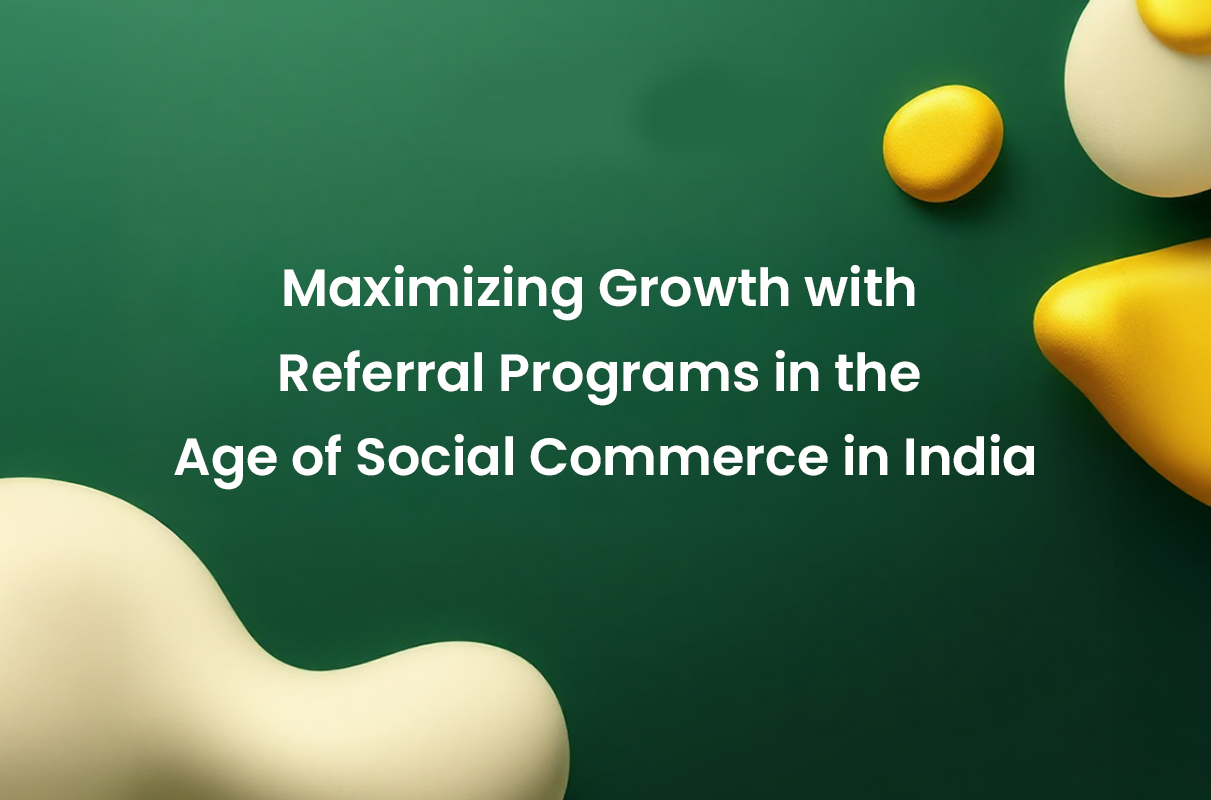
Maximizing Growth with Referral Programs in the Age of Social Commerce in India
Explore how referral programs powered by social commerce are transforming customer engagement and loyalty in India’s booming digital market.
Maximizing Growth with Referral Programs in the Age of Social Commerce in India
India’s social commerce landscape is witnessing unprecedented growth, reshaping how brands engage customers and channel partners. By 2025, the social commerce market in India is expected to reach between $8.4 billion and $20 billion, growing annually at around 17%. This surge is driven by widespread digital adoption and the rise of platforms like WhatsApp and Instagram, where referral programs are becoming crucial growth engines.
Understanding Social Commerce and Referral Programs in India
Social commerce integrates social interactions with online buying, enabling peer-to-peer product discovery and purchase within social media apps. Referral programs within this ecosystem tap into India’s culturally ingrained word-of-mouth behaviors, amplifying sales through trusted personal networks. These programs incentivize consumers and channel partners via rewards such as instant cashback, experiential perks, and wellness incentives, driving deeper engagement compared to traditional marketing.
Emerging Trends Transforming Referral Programs
Digital rewards have become more instant and versatile, with brands leveraging fintech integrations like UPI-based cashback and Buy Now Pay Later (BNPL) options to attract first-time buyers and empower dealers. Influencer and micro-affiliate programs are flourishing, particularly regional language creators who offer high conversion rates by addressing localized audiences. Referral mechanics increasingly focus on compliance—embracing privacy-first data capture and transparent reward disclosures due to evolving regulations, adding a layer of trust that supports sustainable growth.
RewardPort’s Strategic Perspective and Solutions
At RewardPort, we understand the critical role referral programs play in social commerce success. Our plug-and-play modules seamlessly integrate referral programs with rewards catalogs tailored to target audiences. For consumers, our solutions include instant digital cashbacks, food and wellness vouchers, and entertainment subscriptions that resonate with India’s vibrant youth and family segments. For channel partners and dealers, we offer travel club memberships, multi-brand gift vouchers, and gamification engines that build loyalty and drive repeat engagement. Our case studies reflect real-world success: brands employing referral programs linked to social commerce channels have witnessed improved acquisition, repeat purchase rates, and upselling opportunities. Meesho’s viral referral engine and tiered micro-entrepreneur incentives exemplify how leveraging social commerce plus referrals can create powerful brand ecosystems.
Best Practices for Referral Programs in Social Commerce
– Design rewards aligned with the preferences of your target segment, utilizing RewardPort’s extensive catalog. – Implement gamification and tiered incentives to sustain engagement beyond initial referral success. – Comply with India’s evolving regulatory landscape by ensuring influencer transparency and data privacy. – Leverage platform-specific strengths—WhatsApp for direct communications and Instagram for influencer-driven showcases. – Monitor and measure lifetime value of referred customers using integrated CRM and analytics tools.
Referral programs are central to the next phase of growth in India’s social commerce ecosystem. By combining culturally aligned peer influence with innovative reward mechanics and regulatory compliance, brands can amplify acquisition, engagement, and loyalty. RewardPort’s solutions empower businesses to design, execute, and track referral programs that resonate across consumer and channel partner segments, driving measurable business impact in the evolving digital economy.

Social Media-Led Consumer Promotions in 2026: Insights and Solutions from RewardPort
Explore how AI-driven, hyper-local social media promotions with influencer and instant rewards lead consumer engagement in India in 2026.
Social Media-Led Consumer Promotions in 2026: Insights and Solutions from RewardPort
Social media continues to transform consumer promotions in India, with 2026 shaping up as a pivotal year. The rapid growth in mobile internet access and digital literacy, coupled with advanced AI tools and influencer marketing, is creating rich, immersive, and highly localized promotional experiences. For B2B marketers, trade leaders, and HR/channel heads, leveraging these trends strategically is key to driving engagement, loyalty, and sales velocity in India’s diverse, mobile-first market.
Context: The Rise of AI and Hyper-Localization in Social Media Promotions
India’s social media landscape in 2026 will be characterized by hyper-localization, regional language content, and AI-powered personalization. Brands that succeed will be those who harness data-driven insights to tailor messaging and rewards dynamically across multiple languages including Hindi, Tamil, Marathi, Kannada, and localized Hinglish dialects. RewardPort’s capabilities in crafting regionally relevant loyalty programs backed by AI analytics enable brands to deliver offers that resonate deeply with local consumer segments.
Key Social Media Trends Shaping Consumer Promotions
Video-first content, especially short-form reels and live commerce, dominates the promotional space with platforms like Instagram Reels, YouTube Shorts, and Moj becoming central to campaigns. Influencer marketing continues to expand rapidly, with a sharp rise in trusted nano- and micro-influencers in Tier-2 and Tier-3 cities, offering higher engagement and ROI. RewardPort’s integrated campaigns can seamlessly incorporate influencer tie-ins alongside instant reward mechanisms like QR scan-to-win, scratch cards, and cashback offers, ensuring maximum engagement and conversion. The growing prominence of messaging apps such as WhatsApp for business interactions opens up powerful avenues for channel partner incentives and real-time consumer engagement. RewardPort’s WhatsApp Redemption Flow exemplifies how social platforms can be used to deliver instant redemption rewards, strengthening both consumer satisfaction and trade partner motivation.
RewardPort’s Perspective: Aligning Solutions with 2026 Consumer Dynamics
RewardPort’s diverse execution methods—ranging from gamification, contests, cashback engines, to referral programs—are designed to integrate smoothly with social media campaigns. This ensures relevant reward types, such as OTT subscriptions, movie tickets, travel vouchers, and instant cashback, align effectively with target demographics. For example, youth-centric promotions benefit from OTT and food delivery voucher rewards, while family-oriented campaigns see better traction with travel, dining, and wellness incentives. Our plug-and-play modules like Freebucks or RewardOne facilitate quick rollout of tailored promotions with robust tracking and analytics, essential for optimizing performance in fast-moving social campaigns. Moreover, our case studies demonstrate how channel loyalty programs and dealer incentive schemes leveraging social media and WhatsApp have driven significant uplifts in trade engagement, repeat purchases, and brand recall.
Strategic Takeaways for Marketers and Channel Leaders
1. Prioritize AI-driven personalization for social campaigns, combining real-time data with regional language content to heighten emotional connect. 2. Leverage nano- and micro-influencers for authentic engagement, particularly in emerging markets beyond metros. 3. Integrate instant rewards and gamified elements within social media-led offers to boost participation and virality. 4. Use WhatsApp and similar platforms for frictionless partner and consumer incentive management, streamlining reward redemption. 5. Deploy RewardPort’s plug-and-play modules to efficiently tie promotional execution to measurable business outcomes.
Social media-led consumer promotions in 2026 will be defined by AI-driven personalization, rich regional content, influencer empowerment, and instant rewards that fit a mobile-first Indian marketplace. RewardPort stands at the forefront, offering proven solutions, a broad reward catalog, and deep expertise to help brands execute highly effective, data-driven social campaigns that drive growth and loyalty. Embracing these trends with RewardPort’s platform can unlock substantial competitive advantages and meaningful consumer engagement in India’s dynamic digital landscape.
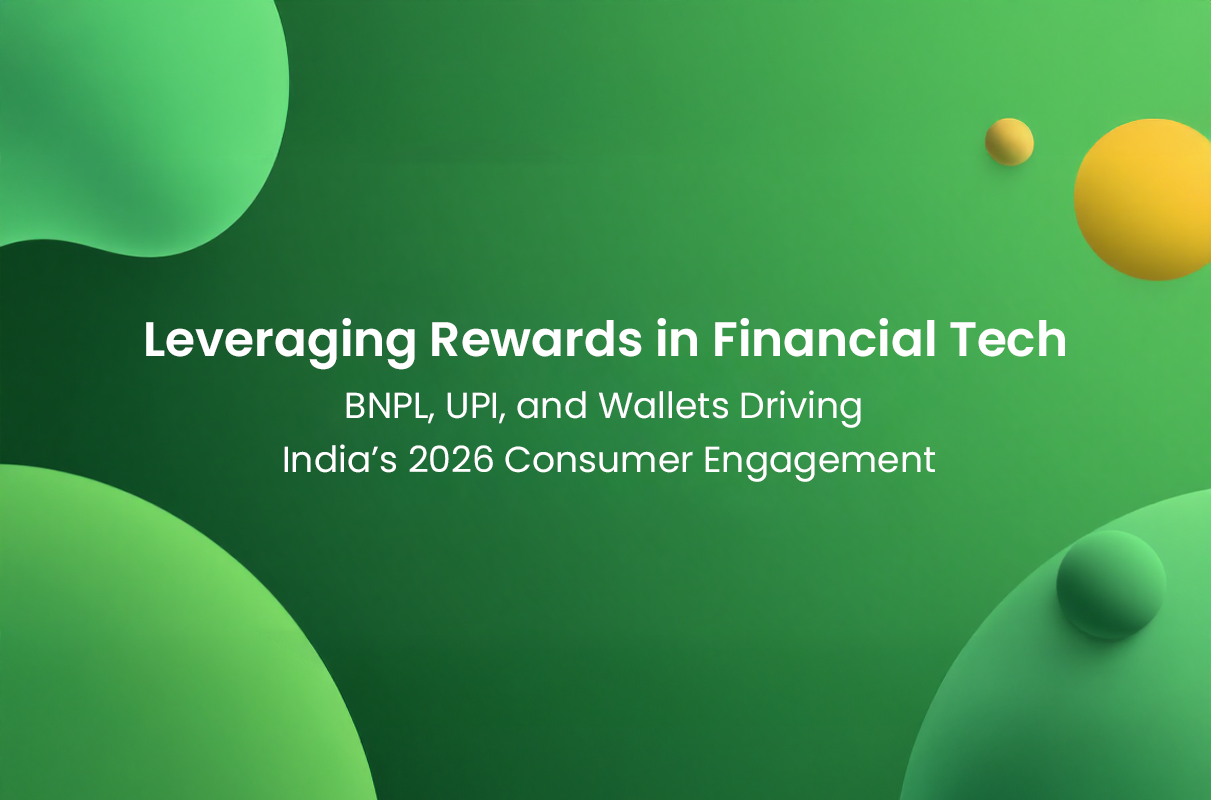
Leveraging Rewards in Financial Tech: BNPL, UPI, and Wallets Driving India’s 2026 Consumer Engagement
Explore how rewards tied to BNPL, UPI, and wallets transform Indian fintech marketing with RewardPort’s solutions and success insights.
Leveraging Rewards in Financial Tech: BNPL, UPI, and Wallets Driving India’s 2026 Consumer Engagement
India’s financial technology sector is booming, with digital payments through UPI, wallets, and BNPL (Buy Now, Pay Later) platforms reshaping consumer behavior and brand engagement. As we look towards 2026, rewards linked to these fintech innovations are becoming pivotal tools for B2B marketers, trade leaders, channel managers, and HR strategists to enhance acquisition, loyalty, and revenue growth. RewardPort, India’s trusted partner in consumer promotions and incentive programs, harnesses this dynamic landscape to deliver impactful, measurable results.
India’s Fintech Landscape: The Rise of BNPL, UPI, and Wallet Rewards
By late 2024, UPI monthly transactions crossed 15 billion in volume, moving nearly USD 280 billion in value, positioning it as a cornerstone payment method for millions nationwide. Wallets and prepaid payment instruments (PPIs), while experiencing slower growth, remain critical for instant payments and merchant incentives. Meanwhile, BNPL is evolving rapidly with tighter regulations ensuring transparent, responsible credit use, and brands increasingly embedding rewards to encourage timely repayments and upsell opportunities. Financial rewards linked to these platforms today go beyond simple cashback to include digital vouchers, instant redemption schemes, and experiential rewards such as wellness and travel—a trend growing fast among India’s increasingly digital and reward-savvy consumers. The growing integration of pay-by-points and gamification mechanics further enhance engagement, especially among younger demographics.
RewardPort’s Strategic Advantage in Fintech-Linked Rewards
At RewardPort, we tailor our promotions to the fintech ecosystem’s pulse. Our plug-and-play modules like Freebucks (points + pay), RewardOne (custom voucher engines), and Channely (channel partner incentives with CRM/ERP integration) are uniquely designed to integrate seamlessly with digital payments channels including UPI, BNPL, and wallets. For example, our collaboration with FMCG and technology clients uses instant disbursal of dealer incentives via UPI combined with tiered loyalty programs and wellness rewards from our extensive catalog to drive channel engagement and repeat sales effectively. Similarly, our cashback engine and gamification solutions power BNPL providers’ campaigns that reward timely repayment and increased product adoption with digital rewards and experiential prizes.
Insights from RewardPort Case Studies
– Dealer & Channel Partner Incentive Programs: Leveraging the Channely platform, clients have implemented real-time UPI wallet incentives with tier upgrades and multipliers, increasing dealer engagement by over 20% quarterly. – Consumer Acquisition via BNPL-linked Rewards: Incorporating our RewardOne vouchers tied to digital wallets encouraged trial purchases and timely payments, leading to a 27% boost in repeat transactions. – Gamified Cashback Campaigns: Using our gamification engine combined with cashback, brands observed higher frequency of purchases during festive seasons driving trial-to-repeat ratio upwards.
Emerging Trends for 2026 and Beyond
The future will see tighter integration of AI and data analytics creating hyper-personalized reward experiences across digital wallets and payments. Wellness and experiential rewards such as fitness memberships, holiday vouchers from VacPac, and dining credits will become mainstream to differentiate offers and deepen emotional brand connections. Regulatory clarity and consumer trust around BNPL will encourage platforms to innovate responsibly with rewards tied to credit health and timely repayments. Further, increasing UPI transaction limits for rural and semi-urban areas will broaden reward program reach, fostering inclusion.
In India’s fast-evolving fintech ecosystem, rewards linked to BNPL, UPI, and wallets are not just value-adds but core strategic levers powering acquisition, loyalty, and channel activation. RewardPort’s deep domain expertise, modular tech solutions, and robust rewards catalog—from instantaneous cashback to travel and wellness experiences—position businesses to scale engagement and ROI in 2026 and beyond.
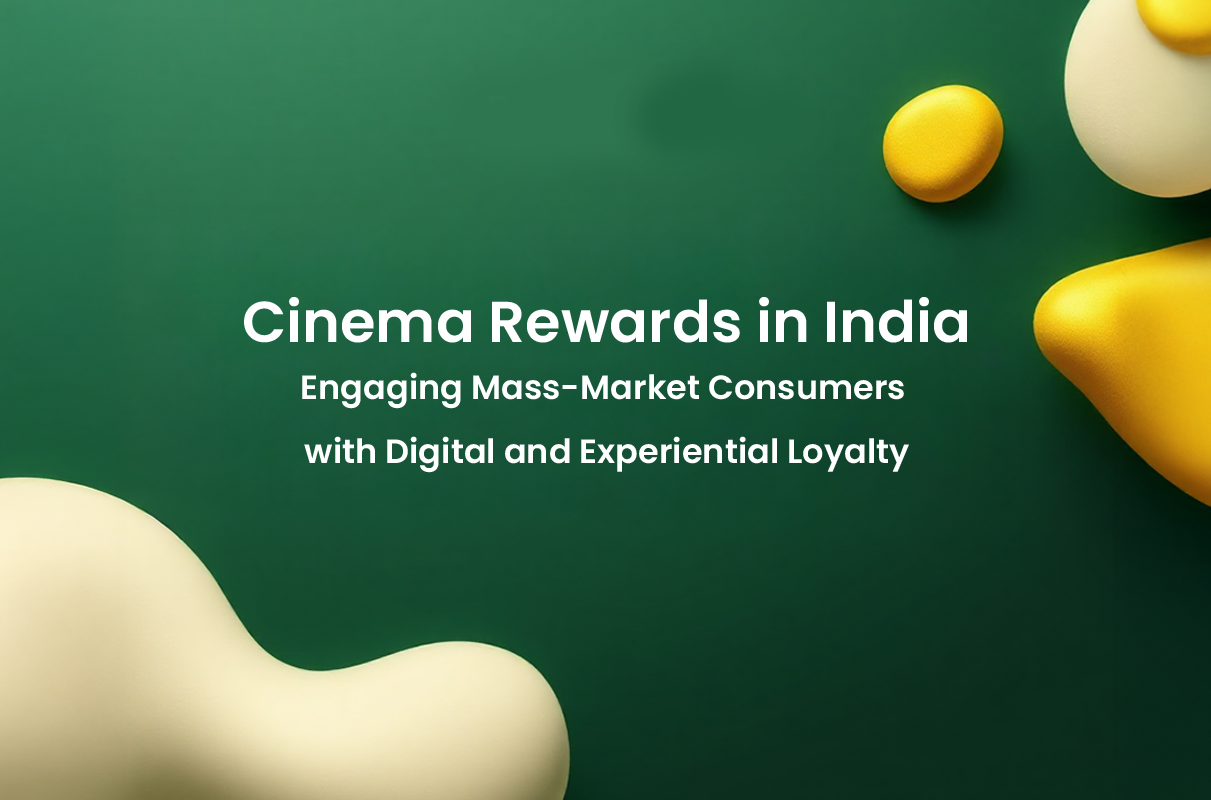
Cinema Rewards in India: Engaging Mass-Market Consumers with Digital and Experiential Loyalty
Discover how cinema rewards connect with mass-market consumers in India through digital, experiential, and instant loyalty programs for sustained engagement.
Cinema Rewards in India: Engaging Mass-Market Consumers with Digital and Experiential Loyalty
In India’s rapidly evolving entertainment landscape, cinema rewards are emerging as a powerful tool to engage the mass-market consumer. As traditional box office revenues face challenges, loyalty and reward programs tailored to India’s diverse consumer base present new opportunities for brands, exhibitors, and channel partners to connect, incentivize, and enhance customer lifetime value. This article explores key trends shaping cinema rewards in India through 2026 and beyond, tying these insights closely to RewardPort’s expertise and solutions that empower businesses to execute high-impact consumer promotions, loyalty programs, and channel incentives.
The Growing Importance of Cinema Rewards in India’s Loyalty Ecosystem
The Indian media and entertainment sector, valued at over INR 2.5 trillion as of 2024, is undergoing transformation driven by digital adoption and changing consumer behavior. Despite a moderate decline in theatrical revenues due to fluctuating footfalls, loyalty programs anchored around cinema experiences continue to offer significant engagement potential. RewardPort’s experience with over 7 million customers annually across 11,000+ programs highlights that consumers increasingly seek not only transactional incentives but experiential and instant rewards that create emotional connections.
RewardPort’s integrated platforms support multiple reward execution methods that resonate with Indian consumers at scale—from digital movie ticket vouchers and cashback rewards to exclusive screenings and gamified experiences. These reward types align tightly with consumer preferences for instant gratification and personalized engagement, thus driving repeat visits and upsell opportunities.
Key Trends Shaping Cinema Rewards in India
1. Digital & Instant Reward Redemption – Indian consumers prefer seamless reward access via mobile apps, digital wallets, and QR-based redemptions. RewardPort’s WhatsApp Redemption Flow and instant cashback campaigns enable quick, hassle-free redemption of cinema rewards, increasing program participation and consumer delight.
2. Experiential Incentives Gain Traction – Beyond transactional discounts, cinema rewards now include VIP screenings, celebrity meet-and-greets, and bundled entertainment experiences. RewardPort’s Travel Club and CineRewardz modules facilitate access to movie ticket rewards across 4,500+ screens, incorporating tiered loyalty and exclusive event access to boost consumer affinity.
3. Coalition & Multi-Brand Loyalty Programs – Consumers value versatile reward catalogs. RewardPort’s RewardOne engine powers multi-brand catalogs featuring cinema vouchers alongside dining, travel, and wellness rewards, encouraging cross-category engagement and creating deeper brand loyalty.
4. Channel Partner & Dealer Incentives – Cinema chains and entertainment brands integrate channel incentives that reward distributors and retail partners for promoter efforts. RewardPort’s Channely module with CRM/ERP integrations ensures transparent tracking, tier multipliers, and timely rewards to motivate channel growth.
5. Data-Driven Personalization – Leveraging analytics and consumer insights underpins campaign effectiveness. RewardPort’s platforms enable sophisticated data capture and segmentation, facilitating tailored reward offers that boost ROI and customer retention.
RewardPort’s Proven Solutions Driving Cinema Reward Success
RewardPort champions a full-lifecycle approach from acquisition through loyalty, integrating proven execution methods based on client case studies:
- Gamification + Instant Redemption: Engagement spikes with branded scratch cards, spin-the-wheel games, and instant coupon deliveries on cinema ticket purchases.
- Gift with Purchase: Assured movies tickets or cashback with product bundles have driven penetration growth for FMCG brands linked with cinema rewards.
- Tiered Loyalty Programs: RewardPort’s tiered reward structures encourage higher spend and repeat visits through exclusive benefits and experiential perks aligned with cinema brands.
Our robust reward catalog includes OTT subscriptions, multi-brand gift vouchers, dining, travel, wellness services, and more—each strategically selected for Indian mass markets to ensure relevance and high redemption rates. This comprehensive offering enables cinema campaigns to appeal broadly while delivering measurable business impact.
Unlocking Mass Consumer Engagement with RewardPort’s Cinema Rewards Expertise
As cinemas compete for consumer attention amid a crowded entertainment environment, rewards programs anchored by technology, personalization, and experiential value are essential. RewardPort’s comprehensive suite of loyalty and incentive solutions, backed by deep market insights and a rich rewards catalog, empowers marketers and channel leaders to drive sustained engagement and growth across India’s mass-market consumers. Partnering with RewardPort means leveraging best-in-class execution models, from instant cashback to immersive gamified campaigns, tailored for the dynamic Indian cinema ecosystem into 2026 and beyond.
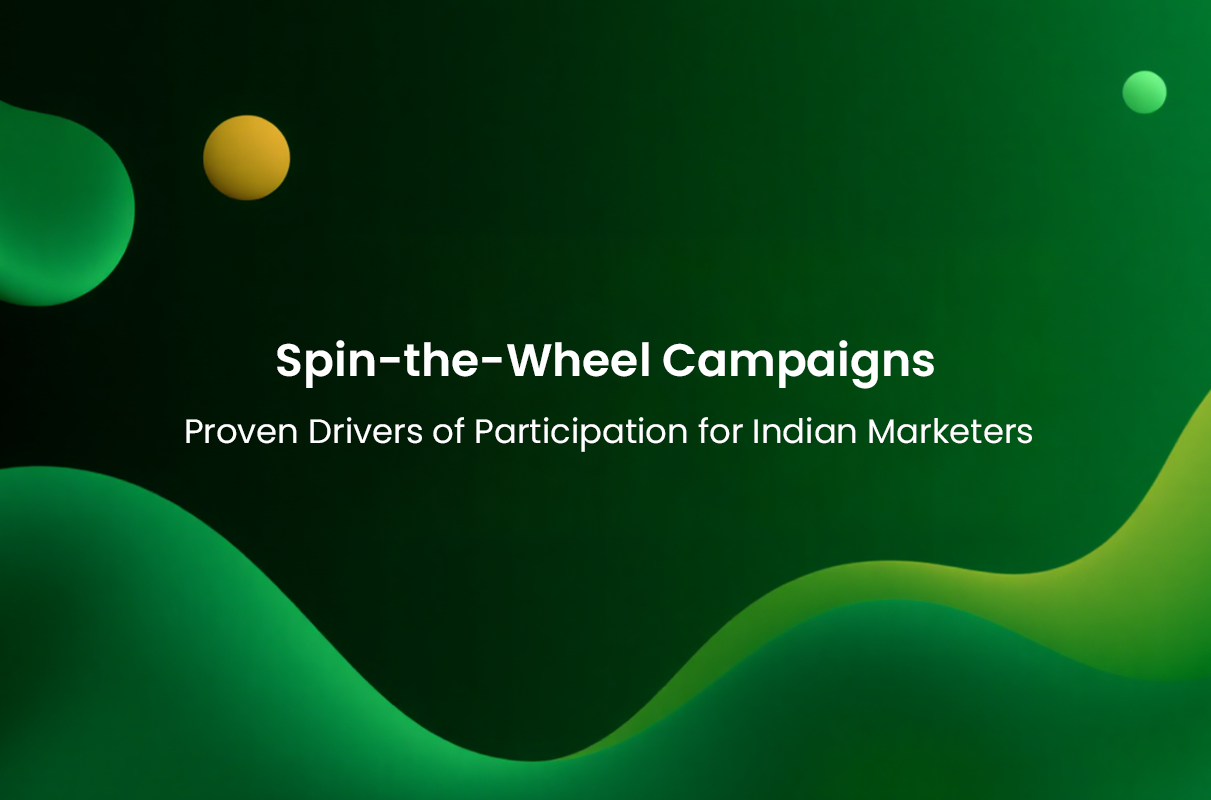
Spin-the-Wheel Campaigns: Proven Drivers of Participation for Indian Marketers
Explore how spin-the-wheel campaigns boost engagement and loyalty in India with instant rewards and personalized experiences.
Spin-the-Wheel Campaigns: Proven Drivers of Participation for Indian Marketers
Spin-the-wheel campaigns have emerged as highly effective tools for consumer promotions, loyalty programs, and channel partner incentives in India. Between 2024 and 2026, they have gained traction due to their dynamic engagement features and ability to deliver instant gratification, making them a favored tactic among B2B marketers, trade leaders, and HR/channel incentive planners.
Why Spin-the-Wheel Campaigns Drive High Engagement
Data from recent Indian market campaigns indicate spin-the-wheel models consistently achieve participation rates of 30–40%, outperforming traditional static rewards like coupons or point systems. This high engagement is primarily due to the game’s element of chance combined with instant rewards, which appeals to consumer psychology and the desire for immediate benefits. The perceived fairness and transparency of spin-the-wheel odds also foster trust, encouraging repeat participation from consumers and channel partners alike. For Indian brands, leveraging digital platforms such as mobile apps, WhatsApp, and QR codes at points of sale facilitates seamless omnichannel engagement, even in tier-2 and tier-3 cities.
Trends in Reward Types and Campaign Execution
Successful spin-the-wheel campaigns integrate diverse rewards that cater to varied audiences. Popular incentives include instant cashback, UPI credits, mobile recharges, shopping vouchers, and wellness gifts such as health checkups and fitness app subscriptions. Wellness and experiential rewards see increased uptake among younger demographics, especially Gen Z and young professionals. On the B2B front, spin-the-wheel mechanics have proven their worth in dealer and channel partner programs. Incentivizing sales targets with gamified rewards can boost order frequency by 20–45%, moving beyond conventional slabs-based incentives. This not only drives higher sales but also enhances partner loyalty. Personalization is an emerging trend where campaign platforms tailor wheel odds and rewards based on participant history and segmentation. This strategic approach ensures sustained engagement and higher campaign ROI.
RewardPort Perspective and Solutions
At RewardPort, we understand the critical balance between fun and strategic objectives in spin-the-wheel campaigns. Our gamification engine supports over 100 branded game formats, including spin-the-wheel, enabling brands to run seamless, engaging campaigns with robust tracking and analytics. Moreover, our Reward Catalog offers a vast selection of rewards across travel, entertainment, food, health & wellness, essentials, and gift vouchers—ensuring the prize mix aligns perfectly with target audiences. For example, integrating movie tickets and pizza vouchers appeals to younger consumers, while travel and dining vouchers resonate with family segments. Our case studies reflect these insights: channel partner programs using spin-the-wheel mechanics have shown measurable uplifts in engagement and sales. By integrating instant digital rewards with personalized redemption experiences, RewardPort clients see stronger loyalty and repeat participation.
Regulatory Considerations and Best Practices
Brands must ensure compliance with Indian regulations by structuring spin-the-wheel campaigns without participation fees and linking spins to legitimate purchase or engagement activities. Transparent communication regarding odds and rewards is essential to maintain consumer trust and avoid perceptions of gambling. Brands are encouraged to leverage data-driven insights from campaign analytics to refine audience segmentation and optimize reward allocation, driving consistent program improvement.
Spin-the-wheel campaigns offer a proven, dynamic method to increase participation and loyalty in diverse Indian market segments. When executed with a balanced rewards strategy and supported by digital engagement platforms like RewardPort, these campaigns deliver measurable uplift in customer and channel partner engagement, translating directly into business growth.
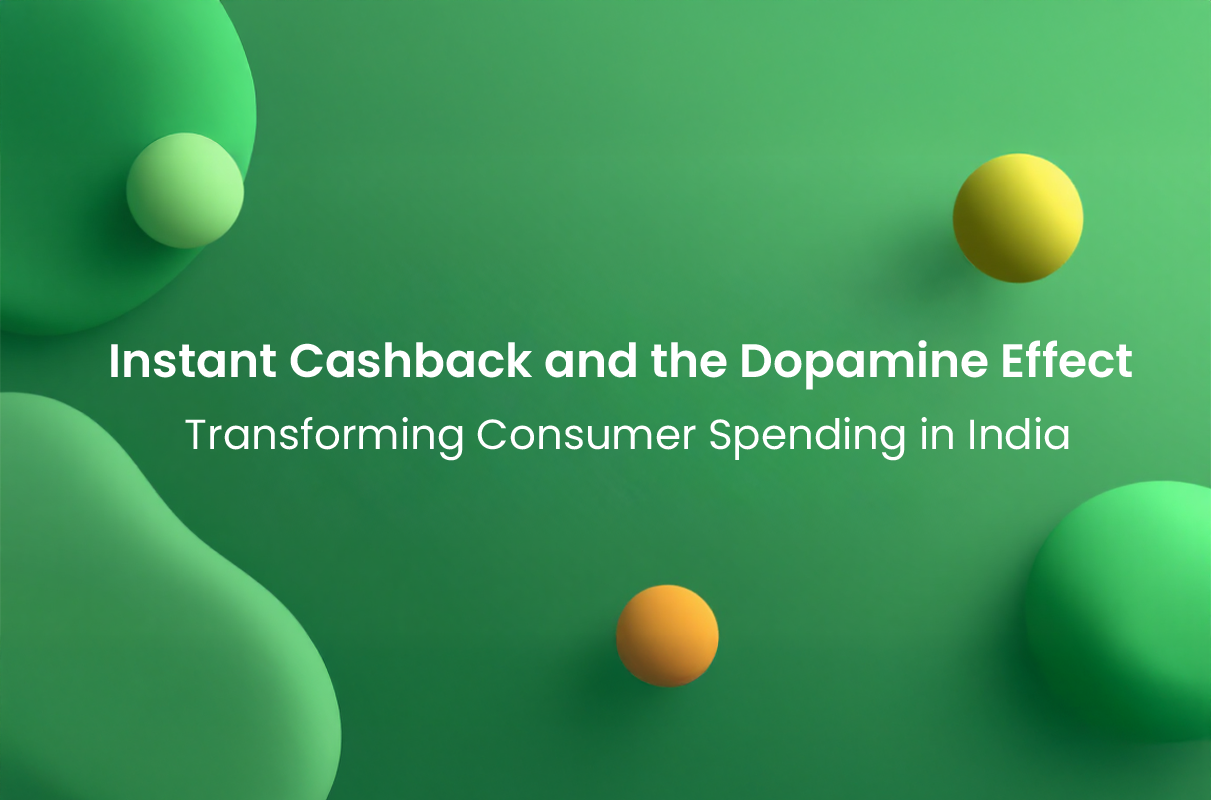
Instant Cashback and the Dopamine Effect: Transforming Consumer Spending in India
Explore how instant cashback leverages dopamine-driven rewards to boost consumer spending, loyalty, and engagement in India’s dynamic market.
Instant Cashback and the Dopamine Effect: Transforming Consumer Spending in India
Instant cashback has emerged as a powerful tool in India’s consumer promotions and loyalty programs, deeply influencing spending behavior through the neurochemical dopamine effect. As RewardPort, India’s specialist in consumer promotions, channel incentives, and employee rewards, we recognize that the immediacy of cashback taps into consumers’ desire for instant gratification, enhancing both engagement and loyalty. This article explores the underlying psychology, market trends, and RewardPort’s strategic approach to harnessing instant cashback for impactful business outcomes.
The Dopamine Effect: Why Instant Cashback Works
Instant cashback generates a strong dopamine response — a neurotransmitter associated with pleasure and reward — providing an immediate sense of financial gain and satisfaction. This effect encourages consumers to make more frequent purchases, often increasing transaction sizes and brand loyalty. The psychological gratification of instant rewards creates a positive feedback loop, motivating consumers to engage repeatedly with brands offering these incentives.
Market Context: Rapid Growth of Instant Cashback in India
The Indian cashback market is on a robust growth trajectory. Valued at approximately USD 7.6 billion in 2024, it is forecasted to nearly double to USD 14.3 billion by 2029, growing at a compound annual growth rate (CAGR) of 13.4%. This growth reflects expanding digital payment adoption, rising disposable incomes, and increasing consumer preference for value-driven shopping experiences. The number of online shoppers is expected to exceed 270 million by 2024, growing at over 22% annually, further fueling cashback program participation.
Key Sectors and Use Cases
Instant cashback is widely deployed across various sectors: – Consumer Promotions: Platforms like Paytm and Flipkart leverage instant cashback during festivals and sales, driving spikes in transaction volumes and brand engagement. – Loyalty Programs: Credit cards from leading banks offer up to 5% instant cashback, incentivizing repeat card usage and enhancing customer lifetime value. – Channel and Partner Incentives: Businesses use instant cashback to energize channel partners and dealers, improving sales and inventory movement. – Experiential and Wellness Rewards: Integrated cashback rewards now extend to experiences like travel, dining, and health services, appealing to the aspirational Indian consumer.
RewardPort’s Perspective: Crafting Effective Instant Cashback Campaigns
At RewardPort, we design instant cashback campaigns that balance dopamine-driven engagement with strategic marketing goals — from acquisition to loyalty and referral. Our plug-and-play cashback engine allows brands to customize reward structures, ensuring seamless redemption and real-time gratification. By integrating data-driven personalization, we help our clients optimize cashback offers that resonate uniquely with diverse customer segments. Our case studies reveal impactful outcomes: a leading food brand used QR inside-pack cashback with assured rewards plus a high-value appliance draw, significantly boosting repeat purchases. Another consumer electronics campaign combined assured cashback with premium gifts, accelerating stock movement during festive seasons.
Trends Shaping Cashback Programs 2025 and Beyond
– Personalization: Behavioral segmentation enhances relevance and increases redemption rates. – Omnichannel Integration: Bridging offline and online presence ensures wider and more frequent consumer touchpoints. – Experiential Rewards: Consumers increasingly prefer cashback linked to travel, dining, and wellness, which strengthen emotional brand connections. – Dealer & Channel Engagement: Tailored instant cashback schemes for partners improve incentivization and business outcomes.
Instant cashback in India is more than just a financial incentive — it’s a psychological trigger that unleashes the dopamine-driven reward response, boosting consumer spending, loyalty, and partner engagement. By harnessing this effect, RewardPort empowers brands and businesses to create compelling, outcome-driven campaigns that align with evolving market dynamics and consumer expectations.

Instant Rewards: Unlocking the Power of ‘Now’ in Consumer Psychology for Indian Marketers
Explore why instant rewards drive consumer engagement in India. Learn how RewardPort’s solutions leverage ‘now’ to boost loyalty, sales, and channel incentives.
Instant Rewards: Unlocking the Power of ‘Now’ in Consumer Psychology for Indian Marketers
In today’s fast-paced Indian market, the value of instant rewards—immediate incentives delivered at the point of engagement—has risen dramatically. Consumers increasingly expect gratification within moments, not days or weeks. This shift is reshaping consumer psychology and driving new dynamics in loyalty programs, promotions, and channel partner incentives. For B2B marketers, trade leaders, and HR/channel heads, understanding why “now” matters can unlock powerful engagement and competitive advantage.
The Psychology Behind Instant Rewards
Psychologically, instant rewards leverage the primal human desire for instant gratification, creating immediate emotional impact. In India especially, where digital adoption and mobile commerce are booming, consumers exhibit heightened impulsivity and preference for quick results. Studies show that the “10-minute delivery” model in quick commerce (Q-commerce) is a tangible reflection of this mindset, prioritizing speed over price sensitivity.
This instant gratification triggers dopamine release, reinforcing positive buying behavior and increasing repeat purchase likelihood. Social media amplification, scarcity messaging, and influencer endorsements intensify this effect by creating FOMO (fear of missing out) and emotional urgency that prompt faster decisions.
Trends Shaping Instant Reward Campaigns in India
Loyalty programs are evolving from conventional points-based schemes to highly personalized, AI-driven, instant reward models. Leading Indian platforms like Swiggy, Flipkart, and Paytm have revamped their reward structures to emphasize cashback, digital vouchers, and experiential perks that consumers can redeem immediately.
Cashback campaigns deliver concrete, instant value, rapidly outpacing delayed reward schemes. Integration with mobile wallets and UPI ensures frictionless redemption, driving strong consumer satisfaction and retention. On the channel partner front, instant digital rewards and wellness incentives motivate dealer participation effectively, enabling businesses to meet sales targets faster.
RewardPort’s Perspective: Delivering Instant Value at Scale
At RewardPort, our solutions are designed to harness the power of instant rewards tailored to Indian consumers and business ecosystems. Our plug-and-play modules, such as Freebucks—combining point accumulation with instant redemption—perfectly align with the now-first consumer mindset.
Our AI-powered personalization tools optimize reward delivery timing and relevance, contributing in some campaigns to a repeat purchase uplift nearing 27%. Whether through cashback engines, gamification with branded digital games, or WhatsApp-based instant win flows, RewardPort enables brands to create moments of delight and immediate value.
RewardPort’s extensive reward catalog—featuring movie tickets, food vouchers, travel experiences, wellness services, and multi-brand gift vouchers—caters to diverse Indian demographic segments. This breadth empowers marketers to match instant rewards with customer preferences closely, deepening engagement and loyalty.
Case Study Insights
Leading brands enabled by RewardPort have successfully driven up sales and engagement by embedding instant rewards into their campaigns. For example, a consumer goods campaign combining assured cashback with high-value draws saw significant repeat purchase and penetration growth. Channel partner incentive programs leveraging instant digital rewards achieved rapid dealer activation and sustained trade engagement.
Future Outlook: Instant Rewards and Beyond in 2026+
Looking ahead, instant rewards will become even more sophisticated through AI-enhanced hyper-personalization and integration with emerging tech like AR/VR experiential incentives. The consumer’s expectation for seamless, immediate value will continue to accelerate, particularly among India’s digitally native youth and urban families.
Marketers and trade leaders who invest in instant gratification-driven programs will not only capture attention and loyalty but also unlock higher lifetime value and channel advocacy in India’s competitive markets.
Instant rewards are not just a trend but a fundamental shift in consumer psychology that Indian marketers must embrace. At RewardPort, we provide the tools, insights, and rewards catalog to make “now” a powerful ally in building engagement, sales, and loyalty. By prioritizing instant gratification within your promotions and channel incentives, you can meet evolving consumer and partner expectations head-on and build lasting business advantage through 2026 and beyond.
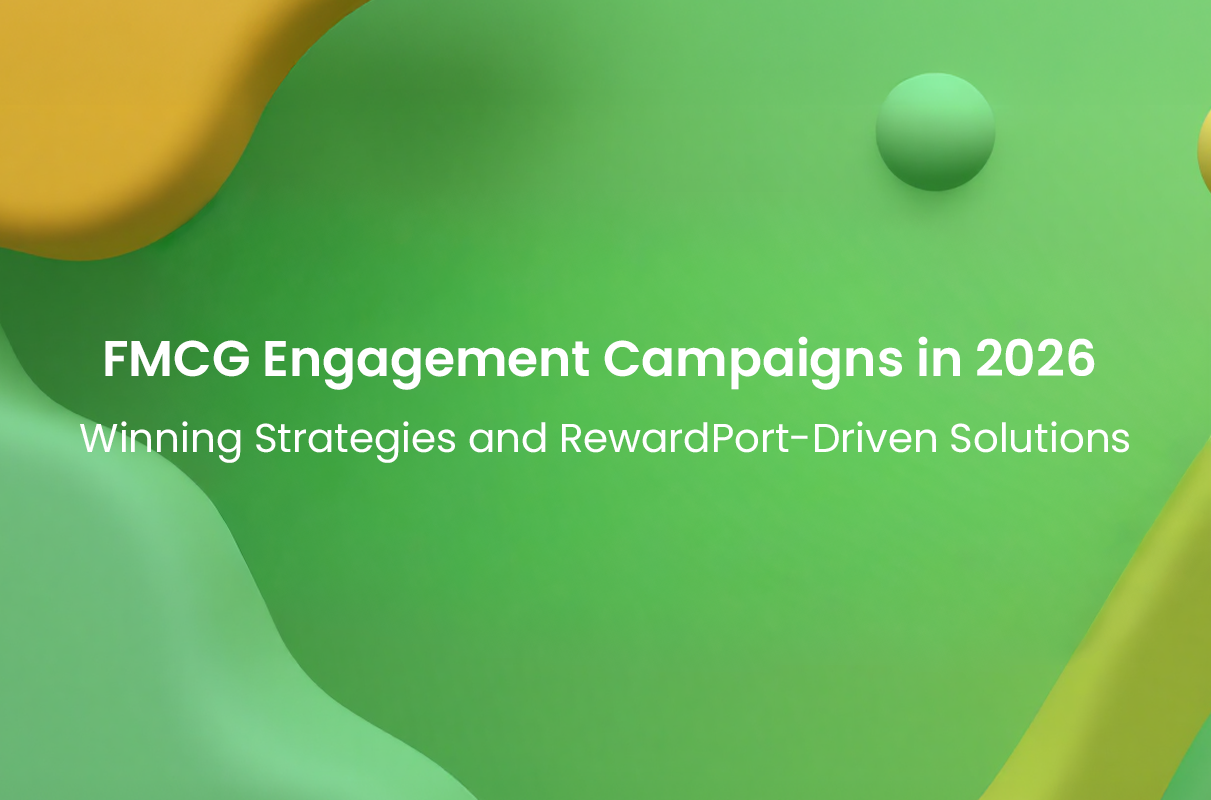
FMCG Engagement Campaigns in 2026: Winning Strategies and RewardPort-Driven Solutions
Explore top FMCG engagement campaigns in India for 2026 and how RewardPort’s loyalty and incentive solutions drive impactful consumer and channel rewards.
FMCG Engagement Campaigns in 2026: Winning Strategies and RewardPort-Driven Solutions
India’s FMCG sector in 2026 is marked by a dynamic shift towards digitally enabled, omnichannel engagement campaigns that harness personalized rewards and robust channel incentives. As consumption patterns evolve across urban and rural markets, brands that excel are those integrating technology-driven loyalty programs with compelling experiential rewards. RewardPort stands at the forefront of this transformation, powering campaigns that connect deeply with consumers, trade partners, and employees alike.
The ongoing growth in digital ad spend, expected to represent over 60% of FMCG marketing budgets by 2026, reflects brands’ commitment to mobile-first, video-rich content alongside traditional platforms. This omnichannel approach strengthens brand recall and maximizes reach across India’s diverse population. RewardPort’s turnkey solutions — from data-driven points loyalty and cashback engines to gamification and experiential rewards catalogues — align perfectly to activate these strategies effectively.
What Works in 2026 (Playbook)
Engagement campaigns that succeed in 2026 share several core traits:
• Omnichannel Integration: Combining TV, digital, print, and mobile amplifies engagement rates up to 35% higher than single-medium campaigns. RewardPort enables seamless coordination across channels with plug-and-play loyalty modules.
• Personalized Loyalty & Instant Gratification: Data-driven segmentation fuels instant cashback, tiered multipliers, and digital wallet redemptions that retain and upsell consumers.
• Channel Partner Incentives: Dealers and retailers gain from tailored point programs, wellness benefits, and curated experiential rewards to boost distribution and motivation.
• Experiential Rewards: Wellness retreats, holiday packages (via RewardPort’s VacPac and AirPac catalogs), and entertainment vouchers foster emotional loyalty beyond transactional benefits.
• Influencer & Celebrity Engagement: Integration with influencer campaigns and celeb endorsements elevates trust and reach—strategies supported by RewardPort’s digital backend for instant reward delivery.
For FMCG marketers and trade leaders, this approach translates into measurable uplifts in repeat purchase, channel activation, and brand advocacy.
RewardPort Case Studies and Solutions in Action
While the 2026-specific FMCG case data is emerging, RewardPort’s ongoing partnerships reveal the effectiveness of its campaign models:
• Multi-Channel Loyalty for a Leading Personal Care Brand: Implementing point accrual combined with tiered rewards boosted repeat purchases by over 25%, leveraging RewardPort’s Freebucks points system with instant redemption.
• Channel Partner Incentives for a Food FMCG Brand: A dealer loyalty program offering quarterly redemption points, wellness vouchers, and merchandise rewards resulted in heightened trade engagement.
• Scratch & Win Campaign with Assured Prizes: For a prominent snack manufacturer, combining assured food vouchers and grand holiday prizes (from RewardPort’s curated catalog) stimulated a 20% uplift in consumer trial and repeat purchase during festive seasons.
• Gamified Referral Program: A beverage brand utilized RewardPort’s gamification engine alongside referral rewards yielding rapid network growth and acquisition lift.
Why RewardPort Is the Partner of Choice
RewardPort’s comprehensive plug-and-play modules provide FMCG brands with the agility to deploy complex campaigns rapidly while maintaining rigorous tracking and redemption transparency. The extensive rewards catalog caters to diverse consumer preferences—from OTT and movie tickets popular with youth to multi-brand vouchers and wellness experiences favored in families and trade partners. Real-time analytics enable course correction and optimization for maximum ROI.
In a market where engagement campaigns must balance fun, attainability, and strategic impact, RewardPort delivers proven models that adapt to evolving consumer behaviour and channel dynamics.
FMCG engagement campaigns in India for 2026 are defined by a blend of digital sophistication, personalized loyalty, and experiential incentives. Brands that integrate these elements effectively benefit from enhanced consumer retention and energized channel partners. RewardPort’s full-suite solutions—spanning loyalty programs, cashback, gamification, and multi-category rewards—equip FMCG marketers and trade leaders to meet these challenges head-on with impactful, measurable campaigns. As the industry moves forward, partnering with RewardPort ensures that engagement strategies remain innovative, scalable, and consumer-centric.
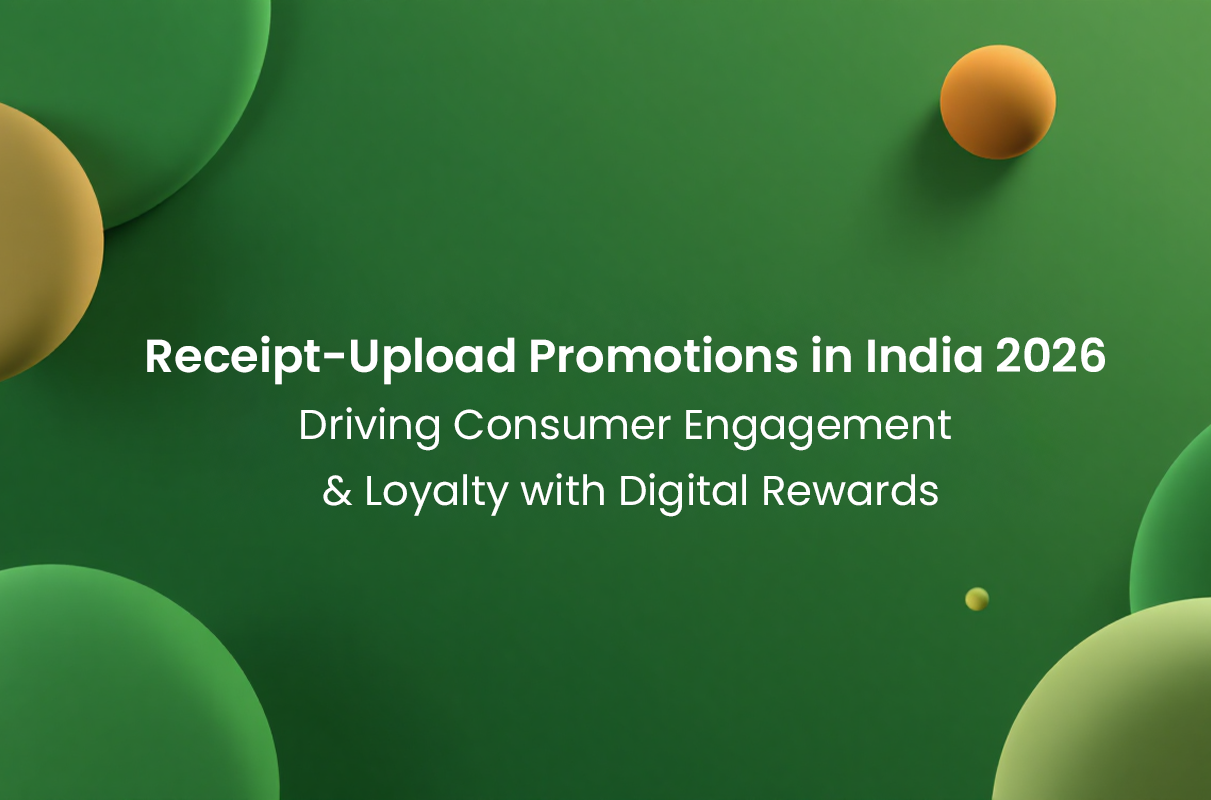
Receipt-Upload Promotions in India 2026: Driving Consumer Engagement and Loyalty with Digital Rewards
Explore receipt-upload promotions in India 2026, their growing consumer adoption, and how RewardPort enables seamless, rewarding campaigns with digital-first solutions.
Receipt-Upload Promotions in India 2026: Driving Consumer Engagement and Loyalty with Digital Rewards
Receipt-upload promotions—where consumers upload proof of purchase receipts digitally to unlock rewards—are rapidly gaining traction across India’s consumer market in 2025 and beyond. This proven activation leverages India’s soaring digital payments ecosystem and widespread smartphone adoption to engage shoppers, deepen loyalty, and incentivize repeat purchases. From FMCG brands to retail chains, these promotions are evolving into multi-channel, omnipresent campaigns that connect physical shopper behavior to digital rewards instantly.
Context and Industry Trends Shaping Consumer Adoption
The last few years have seen explosive growth in digital payment platforms like UPI, Paytm, Amazon Pay, and others, which now serve as critical enablers for receipt-upload campaigns. India’s urban and increasingly rural consumers are comfortable scanning receipts via apps or uploading photos through WhatsApp-led flows, expecting seamless and immediate rewards. According to recent market data, promotions combining cashback, discount codes, and experiential rewards dominate sales advertising, often accounting for over 50% of activations in print and digital promotion spaces by late 2023. This mix resonates well with consumers seeking both instant gratification and aspirational prizes. Moreover, brands are embedding receipt-upload mechanics into loyalty programs to convert one-time buyers into repeat customers. Channel partners and dealers are also incentivized via digital credits or spiffs to promote these campaigns at the point of sale, creating a robust ecosystem that ties consumer behavior with partner engagement. This omnichannel integration ensures broader adoption and sustained momentum into 2026.
RewardPort’s Perspective and Execution Expertise
At RewardPort, we recognize receipt-upload promotions as a cornerstone of India’s future-facing customer engagement strategies. Our plug-and-play modules enable brands to deploy campaigns that drive acquisition, repeat purchase, and up-sell by combining instant cashback, digital vouchers, and experiential rewards such as spa visits or movie tickets—drawing from our comprehensive rewards catalog. Our solutions emphasize ease of participation through mobile apps and WhatsApp, supported by robust invoice validation backend systems that ensure fraud mitigation and data accuracy. By integrating dealer and channel incentives alongside consumer rewards, RewardPort fosters a seamless ecosystem that magnifies impact across the value chain. Case studies within the industry reveal compelling uplifts: FMCG brands partnering with payments players have recorded over 20% increases in repeat purchases during receipt-upload campaigns that reward digital cashback instantly. Retailers leveraging experiential tiers from RewardPort’s entertainment catalog have seen elevated engagement and footfall, particularly in premium urban segments.
Key Consumer Adoption Drivers for 2026 and Beyond
– Digital Payments Penetration: With UPI transactions exceeding 100 billion annually, digital receipt uploads are frictionless and widely accessible. – Omnichannel Loyalty Integration: Combining online and offline purchase data through receipts strengthens personalized marketing. – Reward Diversity: Consumers gravitate towards instant cashback, multi-brand voucher catalogs, and experiences, all easily redeemable. – Channel Partner Engagement: Incentivizing dealers and retailers accelerates adoption at grassroots levels. – Mobile-First and Vernacular Accessibility: Simplified app and WhatsApp-based uploads drive inclusion across urban and rural areas alike.
Embracing Receipt-Upload Promotions with RewardPort
Receipt-upload promotions represent a dynamic confluence of digital innovation, consumer psychology, and multi-tier incentives within India’s rapidly evolving retail landscape. RewardPort’s expertise in orchestrating such campaigns—leveraging digital-first execution models and a wide-ranging reward catalog—positions brands to thrive in this vibrant space. As adoption accelerates through 2026, marketers embracing these campaigns with precision and agility will unlock significant growth in customer acquisition, loyalty, and channel engagement.
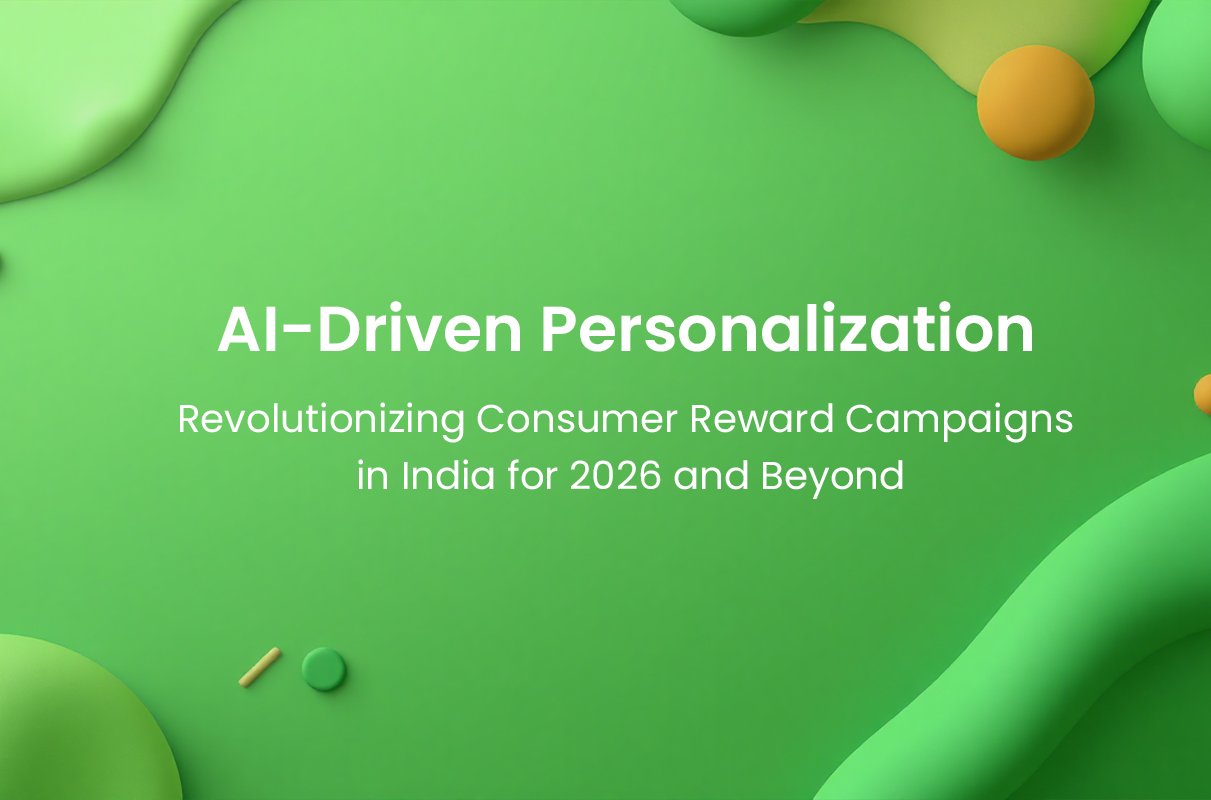
AI-Driven Personalization: Revolutionizing Consumer Reward Campaigns in India for 2026 and Beyond
Explore how AI-driven personalization is reshaping consumer reward campaigns in India with tailored promotions, loyalty programs, and RewardPort solutions.
AI-Driven Personalization: Revolutionizing Consumer Reward Campaigns in India for 2026 and Beyond
AI-driven personalization is rapidly transforming the landscape of consumer reward campaigns in India. With over 95% of Indian consumers now influenced by AI in their purchase decisions, brands are leveraging data analytics and machine learning to offer hyper-personalized rewards that increase engagement, loyalty, and repeat purchases. From digital loyalty programs to cashback campaigns, AI helps marketers reach consumers with relevant incentives that resonate deeply, creating a competitive edge in a diverse and dynamic market.
The Indian Market Landscape and Consumer Expectations
In the India-first context, consumers increasingly expect personalized experiences that reflect their preferences, purchase history, and lifestyle. Reports indicate that 81% of Indian consumers anticipate their favorite brands adopting generative AI for personalization by the end of 2024, pushing brands to innovate rapidly. This trend is especially visible in sectors like FMCG, financial services, and retail, where data-driven reward programs are now standard. AI’s ability to segment customers precisely and deliver instant, contextually relevant rewards enhances customer satisfaction and brand affinity.
Key Trends in AI-Powered Consumer Reward Campaigns
Several emerging trends define AI-driven personalization in consumer campaigns. First, the integration of real-time data analytics enables instant reward decisions tailored to individual behavior, such as AI-powered Scratch & Win or QR Scan to Win campaigns. Second, AI enhances loyalty programs by dynamically adjusting points, tiers, and multipliers based on consumer activity and preferences. Third, AI facilitates hybrid omnichannel experiences combining digital and offline activations, enabling seamless consumer journeys.
Moreover, privacy and data security concerns have led Indian brands to strike a balance between personalization and consumer trust, fostering transparency around data use while delivering value through personalized rewards.
RewardPort’s Perspective and Solutions
At RewardPort, we specialize in crafting AI-powered, tailor-made consumer promotion and loyalty programs uniquely suited for the Indian market. Our plug-and-play modules—such as Freebucks (points and instant redemption), RewardOne (customizable gift voucher engine), and Gamification Engine (with 100+ branded games)—enable brands to deploy sophisticated AI-driven campaigns swiftly and at scale.
We harness data analytics and AI integration to create high-impact campaigns, blending assured rewards like cashback or multi-brand vouchers with experiential travel prizes from our VacPac and AirPac catalogs. This approach delivers measurable results across the full consumer lifecycle: acquisition, trial, repeat purchase, upsell, and loyalty consolidation. For example, our campaigns with leading Indian brands have demonstrated increased consumer engagement and repeat purchase rates through such AI-personalized reward touchpoints.
Case Insights and Outcome Highlights
While respecting confidentiality, RewardPort’s collaborations highlight how AI-personalized campaigns have driven sales uplift and brand loyalty. Initiatives blending AI with instant rewards have increased consumer retention, with some programs seeing a repeat purchase uplift nearing 27%. Our channel and dealer incentive campaigns leveraging AI analytics have also raised trade engagement, showing the broad applicability of personalized reward strategies.
AI-driven personalization in consumer reward campaigns is not just a futuristic concept but a present-day imperative for brands in India. By enabling hyper-personalized, data-backed incentives and seamless redemption experiences, AI fosters deeper consumer connections and stronger brand loyalty. RewardPort’s comprehensive suite of AI-enabled solutions and rich rewards catalog position brands to thrive in 2026 and beyond by meeting evolving consumer expectations with precision and creativity.
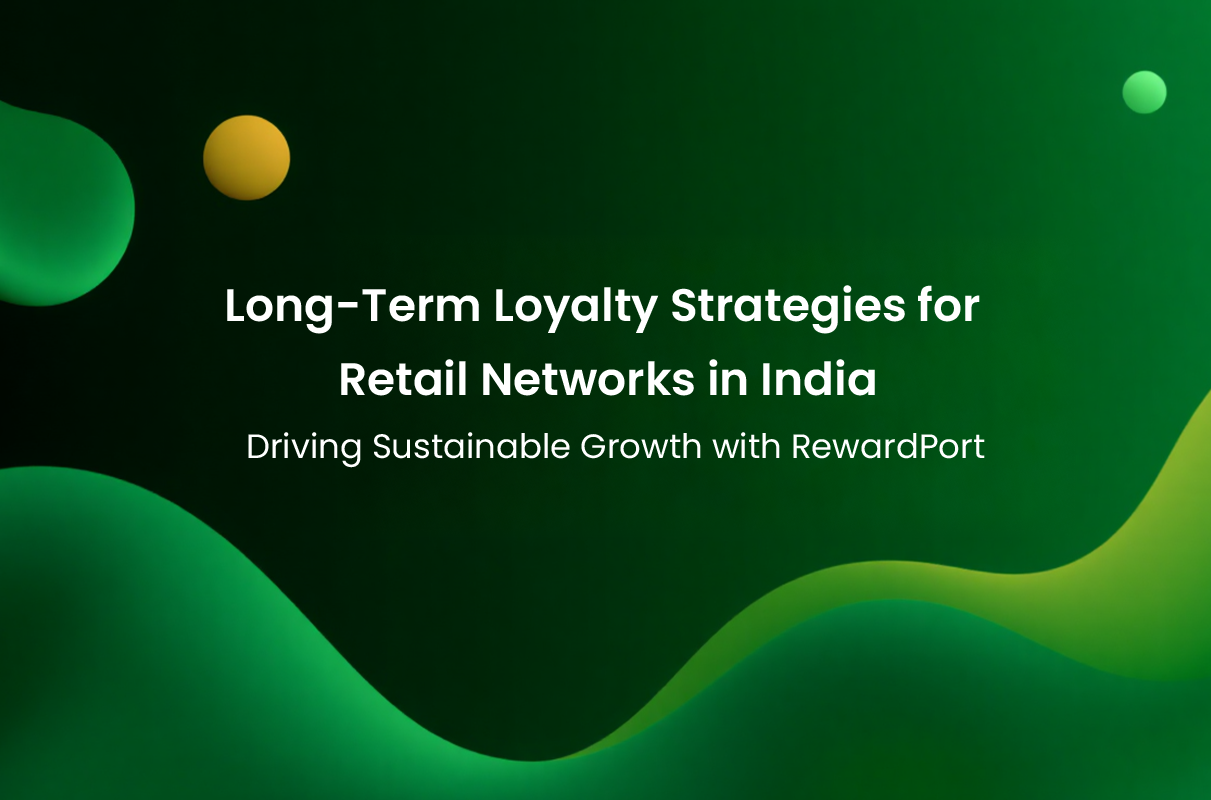
Long-Term Loyalty Strategies for Retail Networks in India: Driving Sustainable Growth with RewardPort
In the fast-evolving Indian retail landscape, fostering long-term customer and channel loyalty has become indispensable for sustainable growth. By 2026, the loyalty market in India is expected to exceed US$3.9 billion, fueled by rising smartphone penetration, digital payment adoption, and shifting consumer expectations. Retailers must implement sophisticated, data-driven loyalty strategies that blend personalization, omnichannel engagement, gamification, and meaningful rewards. RewardPort, as India’s specialist in consumer promotions, loyalty programs, and channel incentives, enables businesses to harness these trends through proven solutions and curated reward catalogs.
Long-term loyalty strategies today center on personalized, mobile-first, and digital-first approaches. Customers crave relevance — programs powered by AI analytics leverage purchase data and behavior patterns to deliver customized offers and rewards. This approach significantly enhances repeat purchase rates and lifetime customer value. RewardPort’s platform facilitates integration with CRM/ERP systems, empowering retailers to automate personalized promotions seamlessly across online and offline channels.
Gamification is another proven driver of engagement. Incorporating digital games such as spin-the-wheel, scratch & win, or branded trivia injects excitement and drives deeper interaction with loyalty schemes. RewardPort’s gamification engine offers over 100 branded games tailored to brand tone and audience that deliver a 50%+ uplift in participation. Coupled with instant gratification rewards like cashback or multi-brand vouchers, these elements cultivate habitual engagement.
Omnichannel loyalty programs are crucial to bridge the offline-online divide, enabling effortless earning and redemption of points or rewards regardless of sales channel. Retailers using such models often see 40% higher program participation. RewardPort’s Channely module supports dealer and channel partner incentive programs with CRM connectivity, optimizing engagement across the distribution network.
The rewards catalog plays a strategic role in driving loyalty. Modern Indian consumers and B2B partners increasingly prefer flexibility and choice—ranging from experiential rewards like travel (VacPac, AirPac), movie tickets (CineRewardz), and dining vouchers to essentials, wellness, and digital subscriptions. RewardPort’s extensive catalog with 150,000+ experience options and thousands of partner outlets allows brands to curate reward mixes that resonate deeply with their target segments.
Sustainability-linked promotions are gaining traction, reflecting growing consumer consciousness in India. Campaigns that incentivize eco-friendly actions such as packaging returns or supporting green products boost brand sentiment and retention. RewardPort has facilitated successful green loyalty initiatives delivering measurable impact on customer engagement.
On the channel side, multi-tiered incentive programs for dealers and partners drive loyalty and sales push effectively. RewardPort’s Channely solution integrates with client ERPs to create milestone-based, tiered rewards that improve payment cycles and strengthen distributor relationships, as seen in multiple client engagements.
In summary, the future of retail loyalty in India demands integrating technology and behavioral insights to create engaging, personalized, omnichannel loyalty ecosystems. RewardPort’s holistic solutions—from AI-based program design and gamification to a rich rewards catalog and channel partner incentives—equip brands to build lasting loyalty. Embracing these strategies will drive sustained growth and competitive advantage in India’s dynamic retail environment through 2026 and beyond.
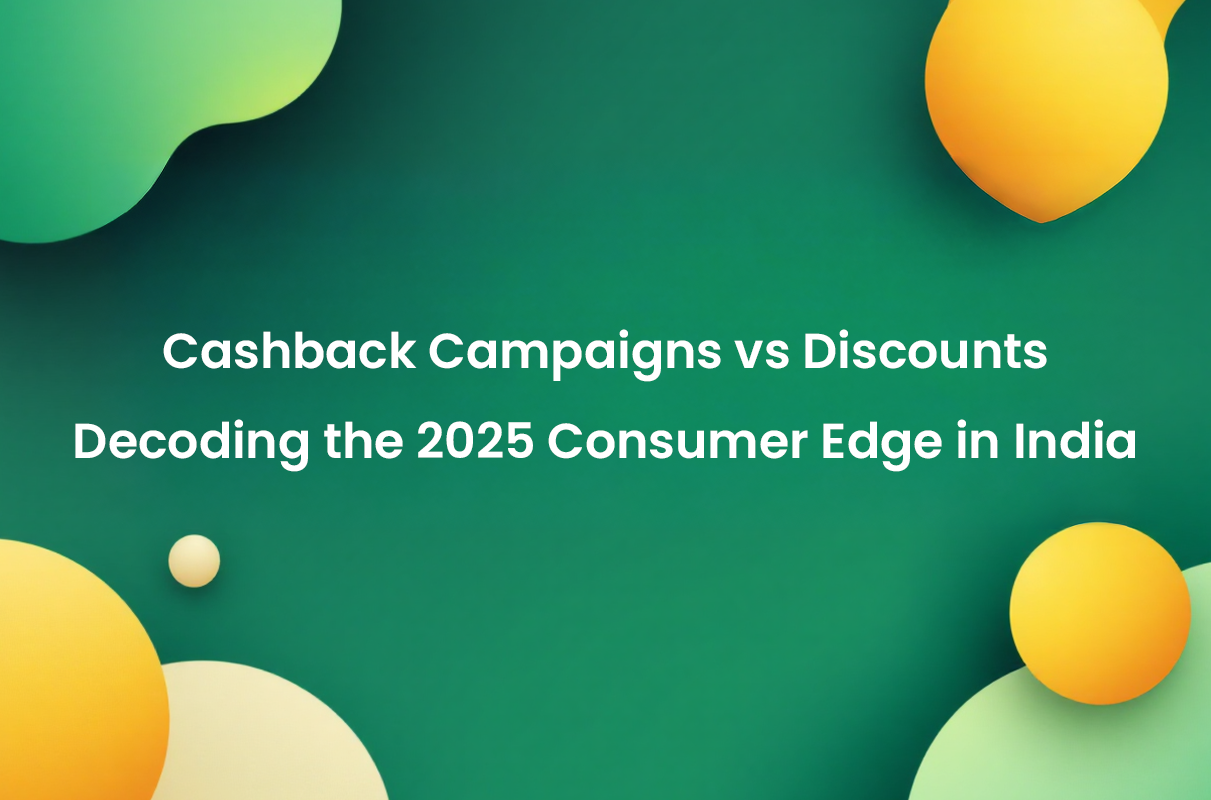
Cashback Campaigns vs Discounts: Decoding the 2025 Consumer Edge in India
As India’s consumer market evolves rapidly toward digital-first engagement, the promotional strategies that marketers adopt must align with shifting preferences and technology trends. Among these strategies, cashback campaigns are increasingly outshining traditional discounts, particularly in driving online shopping and customer loyalty. However, both remain indispensable tools when used thoughtfully in combination.
Consumer behavior in India shows a compelling tilt towards cashback offers. Recent studies indicate that 50% of Indian consumers cite cashback as a key motivator for online purchases, slightly higher than the 46% who prioritize discounts. This preference is most pronounced among younger, metro-based shoppers who value the tangible, wallet-friendly benefits cashback delivers. Conversely, older segments like Gen X still retain a strong affinity for discounts. This generational split suggests that a hybrid strategy addressing diverse consumer needs is optimal.
From a business standpoint, cashback adoption in India has surged with over 22% of online purchases involving cashback incentives. The festive seasons and large sale events see concerted use of combined discounts and cashback mechanisms, which have proven to amplify average order values and customer retention. RewardPort’s experience aligns with these insights: our clients leveraging dual approaches — integrating cashback rewards with targeted discounts — achieve superior engagement and repeat business.
In the channel and trade marketing domain, cashback outpaces discounts by offering faster, more trackable digital payouts, enhancing dealer and retailer incentives programs through real-time rewards. This digital agility supports more personalized reward experiences, an area RewardPort specializes in through modular plug-and-play solutions such as Freebucks points and RewardOne gift voucher engines, which facilitate instant redemption and multilayered reward structures.
The 2025 playbook for promotions in India includes embracing cashback as a cornerstone, especially in high-growth categories like electronics, fashion, and digital services, where consumer responsiveness is highest. Discounts retain their power for price-sensitive groups and initial product penetration but achieve best results when layered with cashback and gamification elements. RewardPort’s catalog, featuring OTT subscriptions, movie tickets, dining, and travel vouchers, supports these mixed reward strategies, delivering experiential value alongside monetary incentives.
Moreover, experiential and wellness rewards are gaining traction as consumers look beyond immediate savings to enrich their lifestyle, a trend RewardPort addresses with rewards such as holiday gift certificates and spa/salon vouchers. Programs incorporating these elements alongside cashback create compelling, differentiated value propositions that resonate with premium segments and foster long-term loyalty.
In sum, cashback campaigns are not merely a fad but a transformative force in India’s consumer promotions landscape for 2025 and beyond. Integrated with discounts and digital engagement tools, cashback drives measurable growth, repeat purchase behavior, and enhanced partnership outcomes. RewardPort stands ready with proven, scalable solutions to help B2B marketers, trade leaders, and HR/channel managers effectively navigate this dynamic landscape and unlock the full potential of their promotions strategies.

